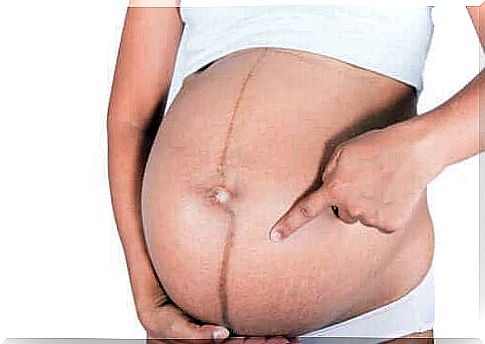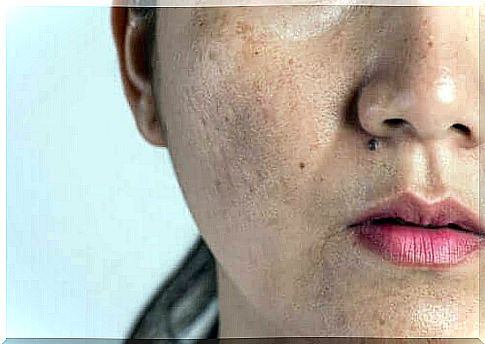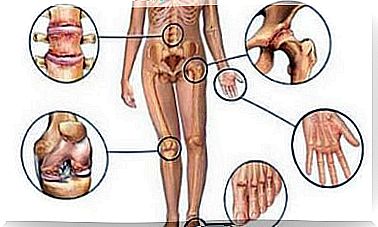Skin Changes During Pregnancy
Hormone changes that occur during pregnancy often lead to skin changes. Although most are benign, this is the time to take extra care of your skin. Learn more about it!

Changes in the skin during pregnancy are caused by changes in the hormonal balance and blood flow. The most common concern of many pregnant women is the appearance of stretch marks. However, they are not the only changes that can occur at this stage. It can also cause blemishes, changes in skin tone, acne, and other skin problems.
According to information published in the Journal of the American Academy of Dermatology , these changes are normal and pose no risk to either the mother or the fetus. However, aesthetically, they can be a major problem for the women affected, and some even seek help from a dermatologist.
In today’s article you will learn everything you need to know about skin changes during pregnancy.
Why do skin changes occur during pregnancy?
The placenta acts as a hormonal organ and increases the activity of the adrenal glands and the pituitary gland. In addition to acting as endocrine glands for the fetus , it causes an increase in corticosteroids, speeds up metabolism, and increases levels of progesterone and estrogen. These are also the hormones that are responsible for skin changes during pregnancy.
Skin changes during pregnancy
The most common skin changes during pregnancy are benign and pose no health risks apart from a possible aesthetic impairment. As an article published in the journal American Family Physician explains, there are pre-existing skin diseases and certain pregnancy dermatoses that, due to the associated risks of increased attention and surveillance need.
Therefore , it is best to see your doctor or dermatologist if you notice any unusual changes on your skin.
Below, we’ll take a closer look at some common skin changes.
Stretch marks
Most often they occur in the area of the abdomen. In addition, they are particularly pronounced in the third trimester of pregnancy. They can also appear on the chest, hips, and buttocks. These stretch marks appear during pregnancy and because of the associated weight gain.
They can be pink or purple. After delivery, they will gradually begin to fade and will no longer be as noticeable. However, in some cases they do not go away completely. Because of this, it is important that you prevent them or treat them in a timely manner.
Whether or not they occur depends on your skin type, its elasticity, and your family history. If you want to prevent stretch marks from occurring, here are some things to look out for:
- Avoid gaining excess weight during pregnancy.
- Use more moisturizers and take extra care of your skin to improve its elasticity.

Skin spots and soft fibroids
These are small stalked papules that are sometimes oblong, brown, or skin-colored and that usually appear in the folds of the neck, the crook of the arm, or under the breasts from the second trimester of pregnancy. Most of them will go away in the puerperium.
Skin changes during pregnancy: hyperpigmentation
This skin change is more common in dark-haired women with dark skin. The linea alba (which is in the middle of the abdomen, vertically from the pubic symphysis to a few centimeters above the navel), the periumbilical area, the external genitalia and the areolas become more intensely pigmented.
From the fifth month onwards, the colored area of the areola called the secondary areola starts to enlarge. In addition , brown or yellowish spots can be seen on the forehead, cheeks, nose, or upper lip. This is known as a pregnancy mask or chloasma.
To prevent these pigment changes, we recommend that you avoid long sunbathing, use a sunblock with a high protection factor (SPF 50), and wear a hat and clothing that protects you from the sun. Although these changes often fade in the months after pregnancy, some women will still retain small patches of skin.
All of these pigment changes are the result of the hormonal changes that occur during pregnancy. They briefly stimulate melanin production, which is responsible for the color of hair, skin and eyes.
In a study published in the International Journal of Dermatology, it was found that pigment changes are the most obvious change in patients. Some women might see their birthmarks increase in size, number, and activity. Often they get darker and bigger. If they start to bleed, we recommend that you see a dermatologist as soon as possible.

Vascular changes
During pregnancy, your blood volume increases, vasodilatation occurs, capillary permeability increases and new vessels develop. These changes in the bloodstream are responsible for the appearance of edema on the limbs, varicose veins, palm rash, and red blood vessels or telangiectasias.
We recommend the following measures to alleviate these symptoms:
- Wear elastic stockings or support stockings.
- Put your legs up.
- Avoid standing on your feet for long periods of time.
- Eat a healthy and balanced diet.
- Drink lots of water.
- Do moderate physical exercise.
Most of these skin changes go away in about 6 months to a year. If they persist, you can treat them using the methods recommended by your dermatologist.
Skin changes: acne
This condition often occurs during pregnancy as the skin’s sebum glands are stimulated and increase their production of sebum. In addition, a mild, moderate, or severe form of acne can develop in any trimester of pregnancy.
Cutis marmorata or marble skin
This is a bluish blotchy discoloration of the skin that can occur during pregnancy. It occurs mainly on the legs when they are exposed to the cold. Usually this subsides in the puerperium. However, if it doesn’t, you should see a dermatologist to rule out other causes.
Skin changes: lighter skin
The skin looks lighter during pregnancy. This is due to two factors. On the one hand, the stimulation of the sebum glands and the associated increased sebum production. On the other hand, the fact that the blood flow in the epithelium increases, which leads to an increased supply of oxygen to the skin cells.
It is important to take good care of your skin during pregnancy
Although most skin changes are considered normal during pregnancy, it is still important that you follow a good care routine and use specific products. Fortunately, there are numerous treatment options today that can help you protect your skin during pregnancy. In addition, it is always a good idea to see a dermatologist if you are unsure or have any questions.









